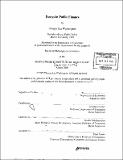| dc.contributor.advisor | Jonathan Gruber and Sendhil Mullainathan. | en_US |
| dc.contributor.author | Washington, Ebonya | en_US |
| dc.contributor.other | Massachusetts Institute of Technology. Dept. of Economics. | en_US |
| dc.date.accessioned | 2005-06-02T16:29:01Z | |
| dc.date.available | 2005-06-02T16:29:01Z | |
| dc.date.copyright | 2003 | en_US |
| dc.date.issued | 2003 | en_US |
| dc.identifier.uri | http://hdl.handle.net/1721.1/17633 | |
| dc.description | Thesis (Ph. D.)--Massachusetts Institute of Technology, Dept. of Economics, 2003. | en_US |
| dc.description | Includes bibliographical references. | en_US |
| dc.description.abstract | This thesis consists of three distinct essays in public finance economics. In the first I use the presence of minority candidates on the ballot to test two implications of the spatial theory of voting. I find, contrary to theoretical predictions, that the magnitude and types of voters who come out to the polls is responsive to the race of the candidate on the ballot. While both black and white voters turn out in greater numbers when there is a black on the ballot, the whites who are propelled to the polls are more often Republican than not. I use this shift in the electorate caused by the racial mix of the candidates as a test of candidate responsiveness, a second implication of the spatial theory. I find evidence in support of this prediction. In Chapter 2 I seek to understand why thirty-five to forty-five percent of low-income American households do not possess a bank account I demonstrate that the low-income household's banking decision responds to the price of savings accounts, particularly their minimum balance requirements. Despite this, I show that government banking regulation to this point has been ineffective in connecting households to transaction accounts. On the other hand, regulation of the fringe banking market has proved more successful. One approach to covering the uninsured that is frequently advocated by policy makers is subsidizing the employee portion of employer-provided health insurance premiums. In Chapter 3, joint with Jonathan Gruber, we study an example of such subsidies: the introduction of pre-tax premiums for postal employees in 1994, and then for the remaining federal employees in 2000. We find that there is a very small elasticity of insurance takeup with respect to its after-tax price, and a modest elasticity of plan choice. Our results suggest that the federal government did little to improve insurance coverage, but much to increase health care expenditures, through this policy change. | en_US |
| dc.description.statementofresponsibility | by Ebonya Lia Washington. | en_US |
| dc.format.extent | 148 p. | en_US |
| dc.format.extent | 5697832 bytes | |
| dc.format.extent | 5697639 bytes | |
| dc.format.mimetype | application/pdf | |
| dc.format.mimetype | application/pdf | |
| dc.language.iso | eng | en_US |
| dc.publisher | Massachusetts Institute of Technology | en_US |
| dc.rights | M.I.T. theses are protected by copyright. They may be viewed from this source for any purpose, but reproduction or distribution in any format is prohibited without written permission. See provided URL for inquiries about permission. | en_US |
| dc.rights.uri | http://dspace.mit.edu/handle/1721.1/7582 | |
| dc.subject | Economics. | en_US |
| dc.title | Essays in public finance | en_US |
| dc.type | Thesis | en_US |
| dc.description.degree | Ph.D. | en_US |
| dc.contributor.department | Massachusetts Institute of Technology. Department of Economics | |
| dc.identifier.oclc | 54771759 | en_US |
